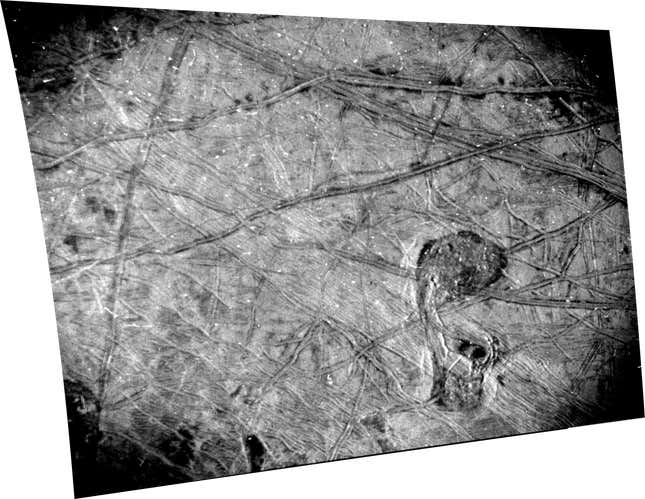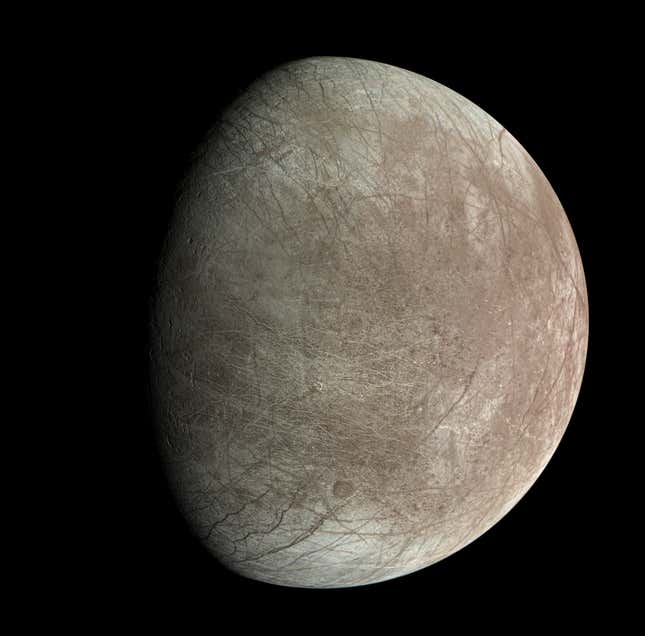On September 29, 2022, NASA’s Juno spacecraft made its closest flyby of Europa, coming to within 220 miles (355 kilometers) of the Jovian moon’s frozen surface. The closeup view of Europa revealed incredible details of the moon’s chaotic terrain, which suggest that its icy crust is not where it used to be. The images also showed a newly discovered feature that was nicknamed “Platypus” for its odd shape.
Kingdom of the Planet of the Apes’ Director on the Film’s Opening
The findings, made possible by the JunoCam images, were recently published in the Planetary Science Journal, while the results derived from the spacecraft’s high-resolution images, captured by its Stellar Reference Unit (SRU), were published in the journal JGR Planets.
Europa is believed to harbor a salty ocean beneath its icy crust that holds twice as much water than all of Earth’s oceans combined, according to NASA. The moon’s rough terrain features intricate networks of ridges and dark stains, suggesting possible plumes of water vapor that may be venting into space.

The black-and-white image of Europa’s surface was captured by Juno’s SRU during the close flyby, and it reveals a region crisscrossed with a network of fine grooves and double ridges, or pairs of long parallel lines, which indicates elevated features in the ice. The small white dots seen across the image are high-energy, penetrating particles, which are the result of the severe radiation environment around the moon. Meanwhile, the dark stains may be linked to the bubbling up of liquid from beneath the ice (also known as cryovolcanic plume activity).
At the bottom right of the image is the Platypus, which measures 42 miles (67 kilometers) at its widest. It features prominent ridges and dark reddish-brown material, with a lumpy matrix material filled with blocks of ice measuring between 0.6 to 4.3 miles (1 to 7 kilometers) wide.
Around the edges of Platypus, ridge formations collapse into the pronounced feature. These formations support the theory that the moon’s icy shell may give way in regions where pockets of briny water from the subsurface ocean lurk beneath the surface. “These features hint at present-day surface activity and the presence of subsurface liquid water on Europa,” Heidi Becker, lead co-investigator for SRU at NASA’s Jet Propulsion Laboratory, said in a statement.

The images captured by the visible light camera aboard the Juno spacecraft, the JunoCam, reveal show the fractures, ridges, and bands that crisscross the moon’s surface in great detail. These features on the surface of Europa have erased terrain older than about 90 million years, according to NASA.
These surface features support a theory that Europa’s outer ice shell moves around and is essentially free-floating. The “true polar wander” theory, as its known, claims that the icy crust at the north and south poles of Europa is not where it used to be.
“True polar wander occurs if Europa’s icy shell is decoupled from its rocky interior, resulting in high stress levels on the shell, which lead to predictable fracture patterns,” Candy Hansen, a Juno co-investigator who leads planning for JunoCam at the Planetary Science Institute in Tucson, Arizona, said in a statement. “This is the first time that these fracture patterns have been mapped in the southern hemisphere, suggesting that true polar wander’s effect on Europa’s surface geology is more extensive than previously identified.”
The JunoCam images prompted a reassessment of a notable feature on Europa’s surface. Hansen noted that Gwern, initially thought to be a 13-mile-wide (21-km-wide) impact crater, was actually intersecting ridges creating an oval shadow.
NASA’s Juno mission launched in 2011 to explore Jupiter and its various moons. Europa is of special interest to scientists as they want to know whether life could have evolved on the icy moon. That’s why the moon is getting more spacecraft to probe its odd features. NASA’s Europa Clipper mission is expected to arrive at Jupiter in 2030 and study Europa’s magnetic field to confirm whether an ocean does exist beneath its icy crust. The European Space Agency’s JUICE mission is on its way to the Jovian system to explore the gas giant and its three ocean-bearing moons.
For more spaceflight in your life, follow us on X and bookmark Gizmodo’s dedicated Spaceflight page.






